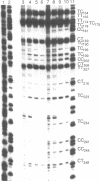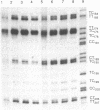Abstract
Cyclobutane pyrimidine dimers were quantified at the sequence level after irradiation with solar ultraviolet (UVB) and nonsolar ultraviolet (UVC) light sources. The yield of photoproducts at specific sites was dependent on the nucleotide composition in and around the potential lesion as well as on the wavelength of ultraviolet light used to induce the damage. Induction was greater in the presence of 5' flanking pyrimidines than purines; 5' guanine inhibited induction more than adenine. UVB irradiation increased the induction of cyclobutane dimers containing cytosine relative to thymine homodimers. At the single UVC and UVB fluences used, the ratio of thymine homodimers (T mean value of T) to dimers containing cytosine (C mean value of T, T mean value of C, C mean value of C) was greater after UVC compared to UVB irradiation.
Full text
PDF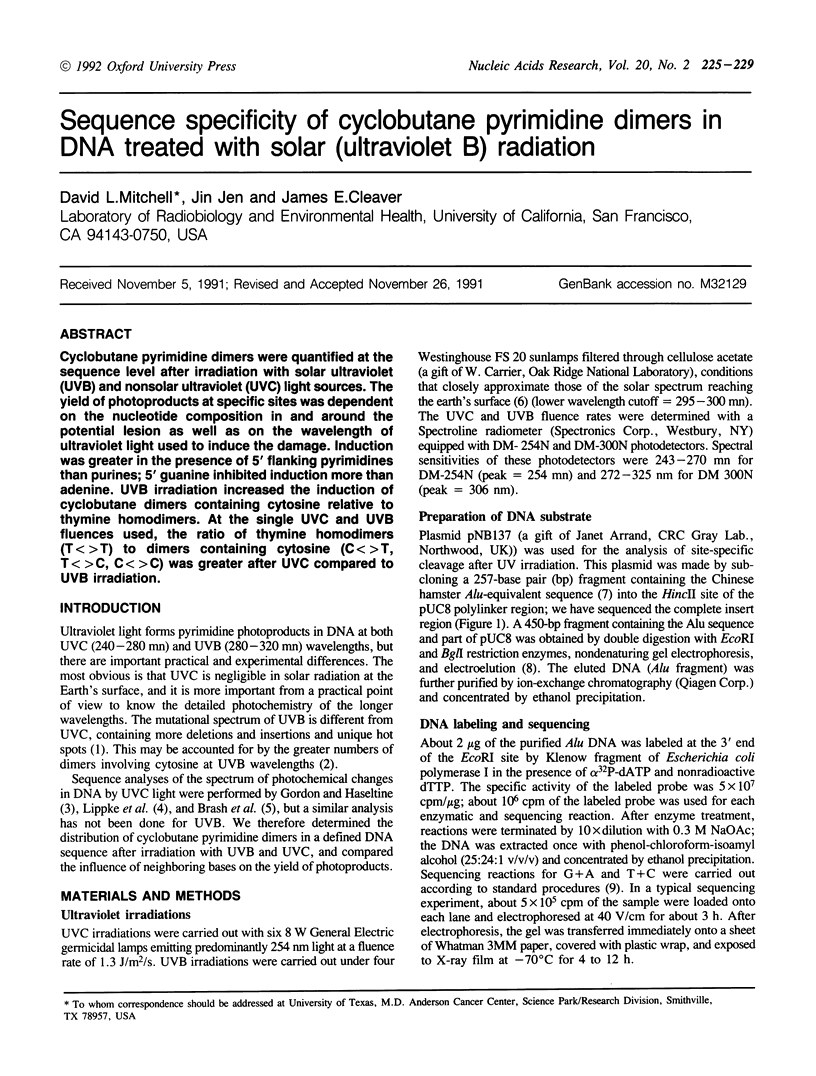
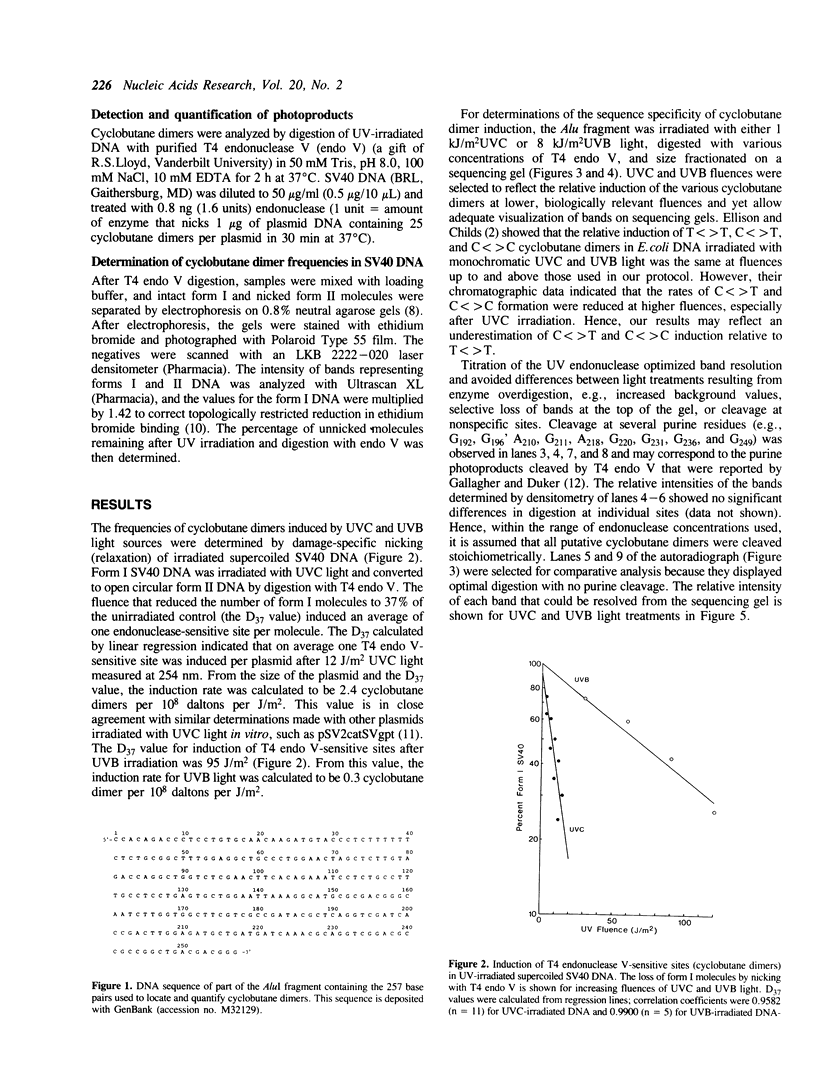
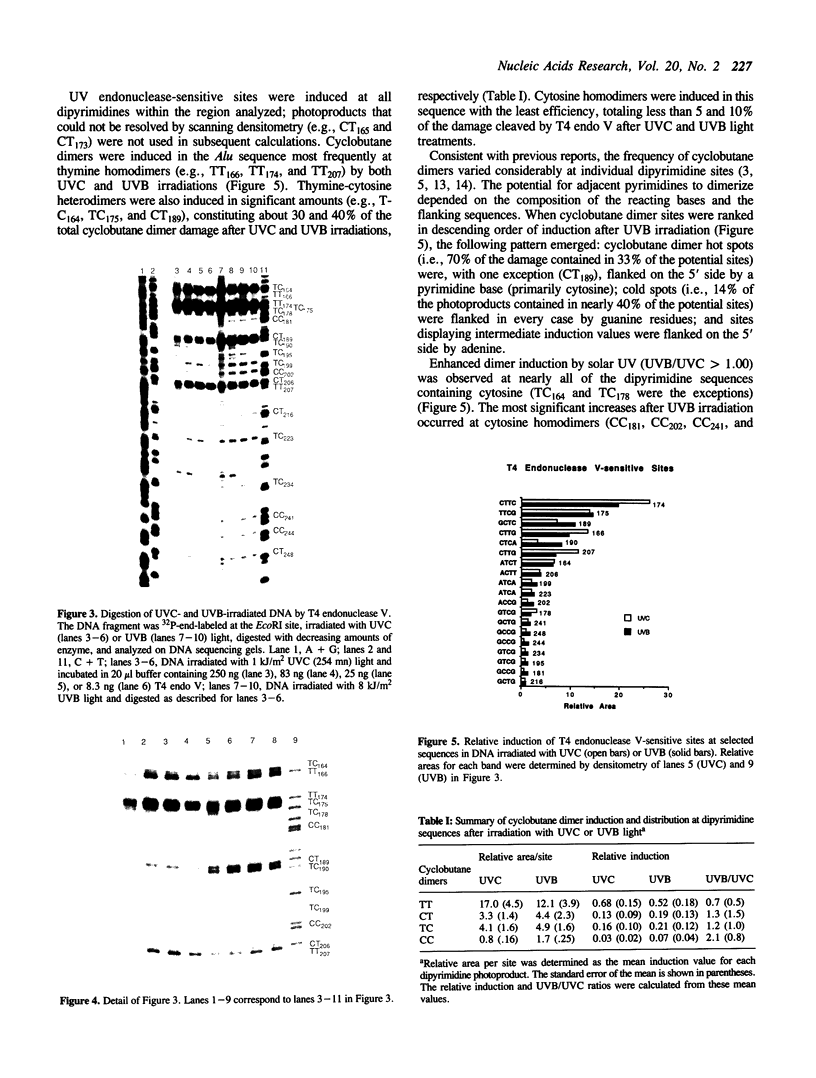
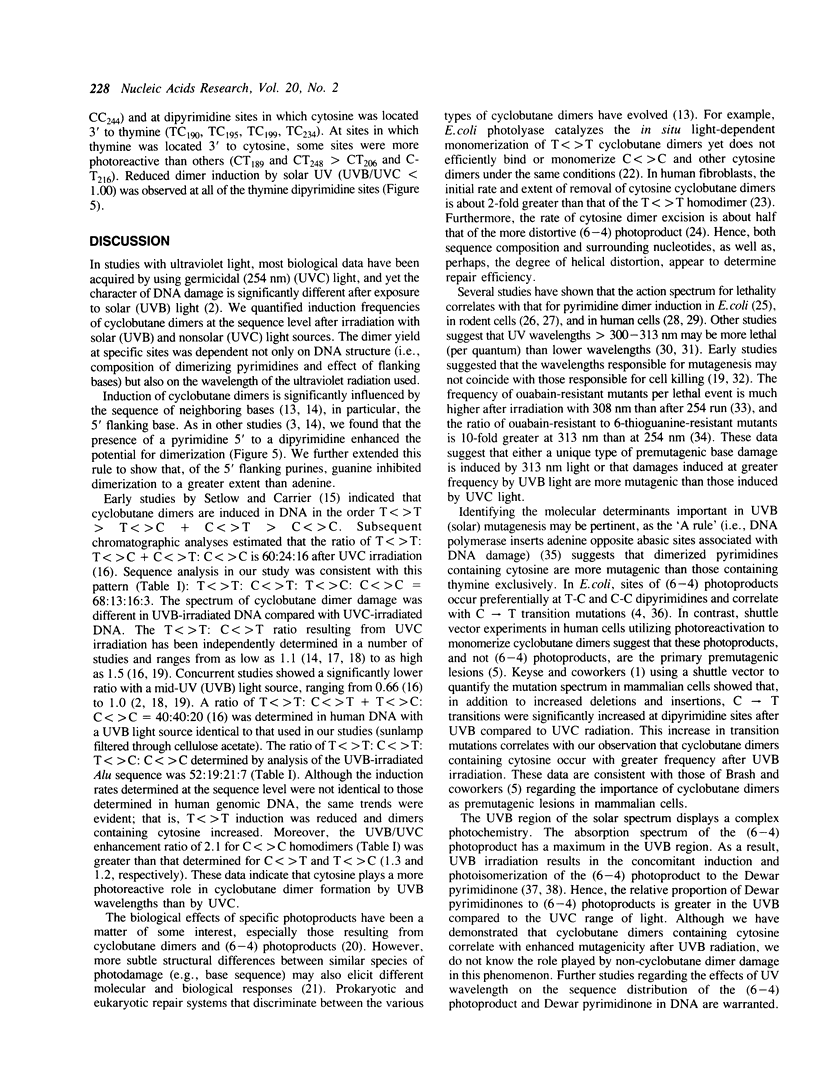
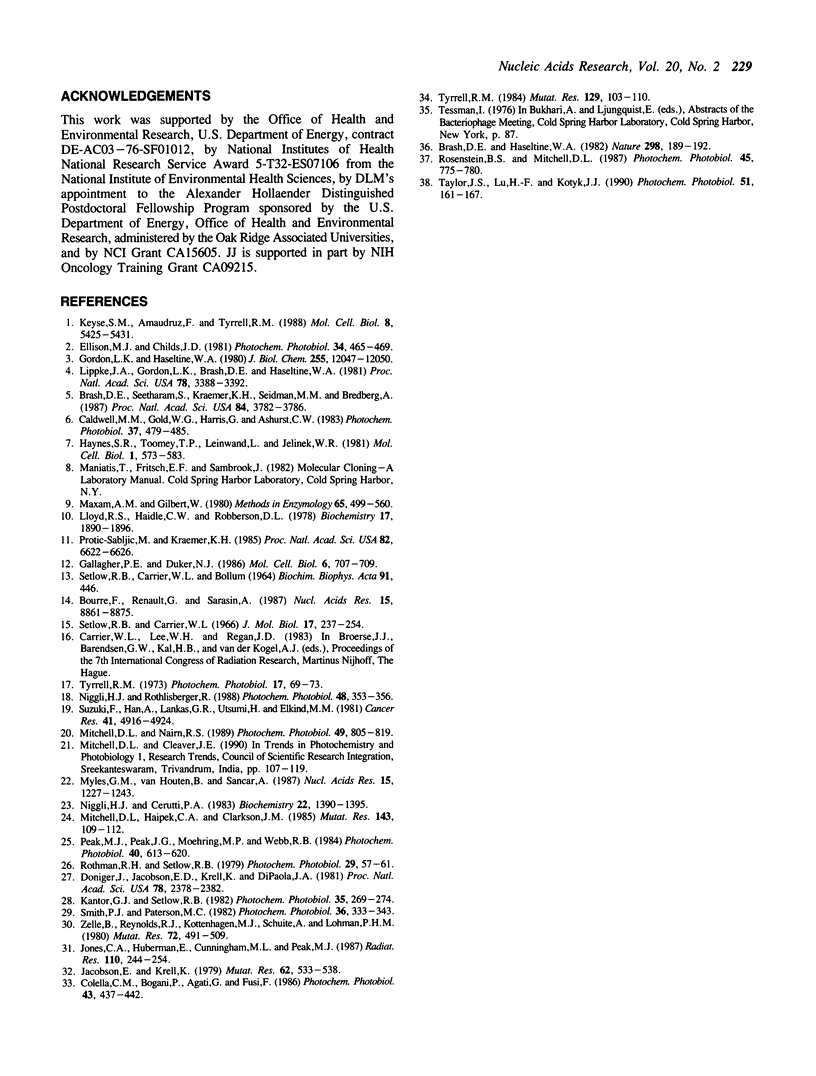
Images in this article
Selected References
These references are in PubMed. This may not be the complete list of references from this article.
- Bourre F., Renault G., Sarasin A. Sequence effect on alkali-sensitive sites in UV-irradiated SV40 DNA. Nucleic Acids Res. 1987 Nov 11;15(21):8861–8875. doi: 10.1093/nar/15.21.8861. [DOI] [PMC free article] [PubMed] [Google Scholar]
- Brash D. E., Haseltine W. A. UV-induced mutation hotspots occur at DNA damage hotspots. Nature. 1982 Jul 8;298(5870):189–192. doi: 10.1038/298189a0. [DOI] [PubMed] [Google Scholar]
- Brash D. E., Seetharam S., Kraemer K. H., Seidman M. M., Bredberg A. Photoproduct frequency is not the major determinant of UV base substitution hot spots or cold spots in human cells. Proc Natl Acad Sci U S A. 1987 Jun;84(11):3782–3786. doi: 10.1073/pnas.84.11.3782. [DOI] [PMC free article] [PubMed] [Google Scholar]
- Caldwell M. M., Gold W. G., Harris G., Ashurst C. W. A modulated lamp system for solar UV-B (280--320 nm). Supplementation studies in the field. Photochem Photobiol. 1983 Apr;37(4):479–485. doi: 10.1111/j.1751-1097.1983.tb04503.x. [DOI] [PubMed] [Google Scholar]
- Colella C. M., Bogani P., Agati G., Fusi F. Genetic effects of UV-B: mutagenicity of 308 nm light in Chinese hamster V79 cells. Photochem Photobiol. 1986 Apr;43(4):437–442. doi: 10.1111/j.1751-1097.1986.tb05626.x. [DOI] [PubMed] [Google Scholar]
- Doniger J., Jacobson E. D., Krell K., DiPaolo J. A. Ultraviolet light action spectra for neoplastic transformation and lethality of Syrian hamster embryo cells correlate with spectrum for pyrimidine dimer formation in cellular DNA. Proc Natl Acad Sci U S A. 1981 Apr;78(4):2378–2382. doi: 10.1073/pnas.78.4.2378. [DOI] [PMC free article] [PubMed] [Google Scholar]
- Ellison M. J., Childs J. D. Pyrimidine dimers induced in Escherichia coli DNA by ultraviolet radiation present in sunlight. Photochem Photobiol. 1981 Oct;34(4):465–469. [PubMed] [Google Scholar]
- Gallagher P. E., Duker N. J. Detection of UV purine photoproducts in a defined sequence of human DNA. Mol Cell Biol. 1986 Feb;6(2):707–709. doi: 10.1128/mcb.6.2.707. [DOI] [PMC free article] [PubMed] [Google Scholar]
- Gordon L. K., Haseltine W. A. Comparison of the cleavage of pyrimidine dimers by the bacteriophage T4 and Micrococcus luteus UV-specific endonucleases. J Biol Chem. 1980 Dec 25;255(24):12047–12050. [PubMed] [Google Scholar]
- Haynes S. R., Toomey T. P., Leinwand L., Jelinek W. R. The Chinese hamster Alu-equivalent sequence: a conserved highly repetitious, interspersed deoxyribonucleic acid sequence in mammals has a structure suggestive of a transposable element. Mol Cell Biol. 1981 Jul;1(7):573–583. doi: 10.1128/mcb.1.7.573. [DOI] [PMC free article] [PubMed] [Google Scholar]
- Jacobson E., Krell K. Ultraviolet wavelength regions implicated in toxic and mutagenic effects on broad spectrum radiation from fluorescent lamps on L5178Y mouse lymphoma cells. Mutat Res. 1979 Oct;62(3):533–538. doi: 10.1016/0027-5107(79)90049-6. [DOI] [PubMed] [Google Scholar]
- Jones C. A., Huberman E., Cunningham M. L., Peak M. J. Mutagenesis and cytotoxicity in human epithelial cells by far- and near-ultraviolet radiations: action spectra. Radiat Res. 1987 May;110(2):244–254. [PubMed] [Google Scholar]
- Kantor G. J., Setlow R. B. Correlation between inactivation of human cells and numbers of pyrimidine dimers induced by sun lamp and 254 nm radiation. Photochem Photobiol. 1982 Feb;35(2):269–274. doi: 10.1111/j.1751-1097.1982.tb03846.x. [DOI] [PubMed] [Google Scholar]
- Keyse S. M., Amaudruz F., Tyrrell R. M. Determination of the spectrum of mutations induced by defined-wavelength solar UVB (313-nm) radiation in mammalian cells by use of a shuttle vector. Mol Cell Biol. 1988 Dec;8(12):5425–5431. doi: 10.1128/mcb.8.12.5425. [DOI] [PMC free article] [PubMed] [Google Scholar]
- Lippke J. A., Gordon L. K., Brash D. E., Haseltine W. A. Distribution of UV light-induced damage in a defined sequence of human DNA: detection of alkaline-sensitive lesions at pyrimidine nucleoside-cytidine sequences. Proc Natl Acad Sci U S A. 1981 Jun;78(6):3388–3392. doi: 10.1073/pnas.78.6.3388. [DOI] [PMC free article] [PubMed] [Google Scholar]
- Lloyd R. S., Haidle C. W., Robberson D. L. Bleomycin-specific fragmentation of double-stranded DNA. Biochemistry. 1978 May 16;17(10):1890–1896. doi: 10.1021/bi00603a014. [DOI] [PubMed] [Google Scholar]
- Maxam A. M., Gilbert W. Sequencing end-labeled DNA with base-specific chemical cleavages. Methods Enzymol. 1980;65(1):499–560. doi: 10.1016/s0076-6879(80)65059-9. [DOI] [PubMed] [Google Scholar]
- Mitchell D. L., Haipek C. A., Clarkson J. M. (6-4)Photoproducts are removed from the DNA of UV-irradiated mammalian cells more efficiently than cyclobutane pyrimidine dimers. Mutat Res. 1985 Jul;143(3):109–112. doi: 10.1016/s0165-7992(85)80018-x. [DOI] [PubMed] [Google Scholar]
- Mitchell D. L., Nairn R. S. The biology of the (6-4) photoproduct. Photochem Photobiol. 1989 Jun;49(6):805–819. doi: 10.1111/j.1751-1097.1989.tb05578.x. [DOI] [PubMed] [Google Scholar]
- Myles G. M., Van Houten B., Sancar A. Utilization of DNA photolyase, pyrimidine dimer endonucleases, and alkali hydrolysis in the analysis of aberrant ABC excinuclease incisions adjacent to UV-induced DNA photoproducts. Nucleic Acids Res. 1987 Feb 11;15(3):1227–1243. doi: 10.1093/nar/15.3.1227. [DOI] [PMC free article] [PubMed] [Google Scholar]
- Niggli H. J., Cerutti P. A. Cyclobutane-type pyrimidine photodimer formation and excision in human skin fibroblasts after irradiation with 313-nm ultraviolet light. Biochemistry. 1983 Mar 15;22(6):1390–1395. doi: 10.1021/bi00275a011. [DOI] [PubMed] [Google Scholar]
- Niggli H. J., Röthlisberger R. Sunlight-induced pyrimidine dimers in human skin fibroblasts in comparison with dimerization after artificial UV-irradiation. Photochem Photobiol. 1988 Sep;48(3):353–356. doi: 10.1111/j.1751-1097.1988.tb02833.x. [DOI] [PubMed] [Google Scholar]
- Peak M. J., Peak J. G., Moehring M. P., Webb R. B. Ultraviolet action spectra for DNA dimer induction, lethality, and mutagenesis in Escherichia coli with emphasis on the UVB region. Photochem Photobiol. 1984 Nov;40(5):613–620. doi: 10.1111/j.1751-1097.1984.tb05349.x. [DOI] [PubMed] [Google Scholar]
- Protić-Sabljić M., Kraemer K. H. One pyrimidine dimer inactivates expression of a transfected gene in xeroderma pigmentosum cells. Proc Natl Acad Sci U S A. 1985 Oct;82(19):6622–6626. doi: 10.1073/pnas.82.19.6622. [DOI] [PMC free article] [PubMed] [Google Scholar]
- Rosenstein B. S., Mitchell D. L. Action spectra for the induction of pyrimidine(6-4)pyrimidone photoproducts and cyclobutane pyrimidine dimers in normal human skin fibroblasts. Photochem Photobiol. 1987 Jun;45(6):775–780. doi: 10.1111/j.1751-1097.1987.tb07881.x. [DOI] [PubMed] [Google Scholar]
- Setlow R. B., Carrier W. L. Pyrimidine dimers in ultraviolet-irradiated DNA's. J Mol Biol. 1966 May;17(1):237–254. doi: 10.1016/s0022-2836(66)80105-5. [DOI] [PubMed] [Google Scholar]
- Smith P. J., Paterson M. C. Lethality and the induction and repair of DNA damage in far, mid or near UV-irradiated human fibroblasts: comparison of effects in normal, xeroderma pigmentosum and Bloom's syndrome cells. Photochem Photobiol. 1982 Sep;36(3):333–343. doi: 10.1111/j.1751-1097.1982.tb04383.x. [DOI] [PubMed] [Google Scholar]
- Suzuki F., Han A., Lankas G. R., Utsumi H., Elkind M. M. Spectral dependencies of killing, mutation, and transformation in mammalian cells and their relevance to hazards caused by solar ultraviolet radiation. Cancer Res. 1981 Dec;41(12 Pt 1):4916–4924. [PubMed] [Google Scholar]
- Taylor J. S., Lu H. F., Kotyk J. J. Quantitative conversion of the (6-4) photoproduct of TpdC to its Dewar valence isomer upon exposure to simulated sunlight. Photochem Photobiol. 1990 Feb;51(2):161–167. doi: 10.1111/j.1751-1097.1990.tb01698.x. [DOI] [PubMed] [Google Scholar]
- Tyrrell R. M. Induction of pyrimidine dimers in bacterial DNA by 365 nm radiation. Photochem Photobiol. 1973 Jan;17(1):69–73. doi: 10.1111/j.1751-1097.1973.tb06334.x. [DOI] [PubMed] [Google Scholar]
- Tyrrell R. M. Mutagenic action of monochromatic UV radiation in the solar range on human cells. Mutat Res. 1984 Oct;129(1):103–110. doi: 10.1016/0027-5107(84)90128-3. [DOI] [PubMed] [Google Scholar]
- Zelle B., Reynolds R. J., Kottenhagen M. J., Schuite A., Lohman P. H. The influence of the wavelength of ultraviolet radiation on survival, mutation induction and DNA repair in irradiated Chinese hamster cells. Mutat Res. 1980 Aug;72(3):491–509. doi: 10.1016/0027-5107(80)90121-9. [DOI] [PubMed] [Google Scholar]



